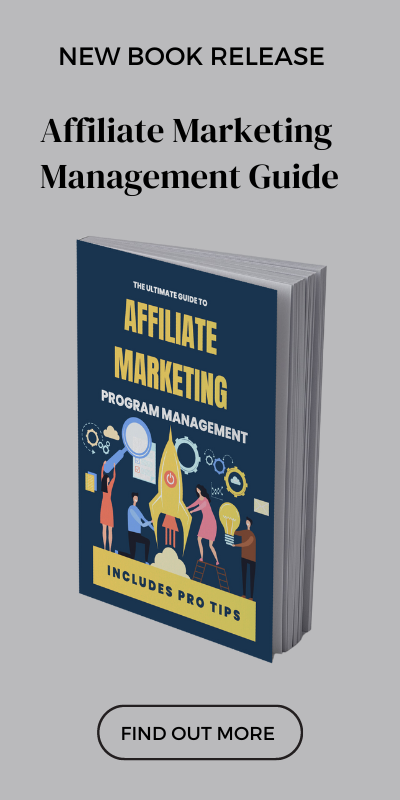Running a successful affiliate program begins before the program has even launched. Scouting the right network, discovering your competitor’s key partners and making sure your commission structure is inviting will all play a part in its success.
But, things don’t stop when you have covered those basics and onboarded a few partners.
The most profitable affiliate programs take ongoing skilled management to keep performance at such a high level.
Some companies, especially if they don’t have specific affiliate skills already within their teams often find themselves lost.
Finding out where your resources should be placed when it comes to program management can be tricky. That is why I have to put together my four main pillars for affiliate success.
Following this strategy and applying just a few of the tactics in this article will set you on the right track for developing an engaged group of affiliates helping to drive orders for your business.
1. Recruitment
Affiliate recruitment is often lauded by those in the industry as the most important and time-consuming area of affiliate program management. Because without recruitment either pre-launch or post-launch the program simply won’t succeed. We need affiliates promoting our brand or services to receive sales.
This task can typically be split into two parts.
The first is passive recruitment, ensuring you are present in key areas so those looking to join your program can find, gather the correct information and then sign-up.
Secondly, you need to be including active recruitment regularly. This involves seeking out new affiliates and persuading them to join your program.
If needed, once you are satisfied you have covered the basics of passive recruitment, assign time weekly (or even daily) to focus on active recruitment. This could be as little as just 10 minutes daily (longer for weekly), but stick to it and be consistent.
Active Recruitment
There is an abundance of different ways to recruit affiliates. Using online tools can help to automate or even speed up the process but without these, you can still be effective.
Initially, the key areas you want to be focusing on for your active recruitment are below:
Key players
These are the guys that will drive the large volume of orders for you. Although, if you are not as well-known as other brands in your sector you may find closed doors with some. It takes time and resources to onboard new brands, larger affiliates want to be sure they will see the return in regards to the commission.
To get a partnership over the line there may need to be a commitment of spending to offset commissions that might take longer for fruition.
Competitors
Who is promoting your competitor’s programs? Find these sites and reach out to them to recruit. The chances are if they are pushing a competitor they will promote you as well.
If need be, sweeten the deal by offering a higher commission rate than your competitor.
Niche sites
Deep diving into your niche is where the rabbit hole begins. For the majority of brands, there could be thousands of sites talking about different areas in your niche.
It will be time-consuming to find, reach out and follow up with these sites. But, it will create a broader portfolio of partners. Just make sure you can incentivise them all successfully.
Passive Recruitment
Affiliates are always searching for new programs to join. For some partners, this is a full-time job and they are constantly on the lookout for brands that their audiences will engage with. Here are some basic passive recruitment methods to cover:
Affiliate page
A great example of passive recruitment is to have an affiliate page on your website. It will show up on Google when someone is searching for you and can help direct prospective partners to your network sign-up page.
Network profile
When websites start with affiliate marketing, their first step is always to sign up to numerous affiliate networks. Refresh your profile and make sure it is as appealing as it can be to potential partners.
Network health check
Network program health checks provide an overview of key performance indicators that might encourage affiliates to sign up for your program. Information like the average earnings per click (EPC) and conversion rates could dictate whether a publisher is willing to put in the time to promote a brand.
Give these KPI’s a once over to see how you compare to other brands in your vertical. If, you are underperforming, think about what you can do to influence these to improve.
2. Activation
By activation, I mean making sure you have as many order active publishers as possible on your program.
To grow and maintain a successful affiliate program, the activation of affiliates needs to begin as soon as they join your program. They need to be engaged from the start and be sold on your brand and program potential.
Don’t rely on generic automated responses from the network. Build your own customer e-mail flow through tools like Media Rails, ConvertKit or MailChimp.
Each email should sell the program to the affiliate and encourage them to promote you.
Some of the information I like to include is:
- Welcome and team introduction
- Brand overview and key values
- Re-enforce onsite converting mechanisms (like free delivery)
- Introduce principal product lines and categories
- Offer content ideas
- Helpful network guides
Emails are drip-fed to the partners over two weeks with a particular theme for each one.
On the back of a robust email flow, you should have in place a commission model that takes into account your brand or program KPI’s while effectively rewarding performance.
At an affiliate category level think about what the publishers requirements are and how important issues like cash flow might play a part.
For example, a Google CSS partner is paying for traffic upfront. Find a way to honour their contribution to the sales funnel while paying swiftly and providing the most accurate product feed possible.
Don’t be afraid to make your affiliate program fun! Introduce competitions, leaderboards and event invites to create a sense of inclusion.
Whether your program is one month old or 10 years old, activation will always play in part in incentivising new partners or re-engaging those that have become stagnant.
3. Compliance
Don’t go to all the hard work of creating program terms and conditions only to not enforce whether partners are sticking to them.
Policing your terms will make sure that no affiliates are gaining an unfair advantage over others. Or, worse still, using black hat techniques to try and win more commission.
Some of the ways I have seen a small bunch of affiliates trying unceremoniously to get the upper hand and steal commissions include:
- Late-night PPC bidding when they think our backs are turned
- Domain squatting and redirecting to the real site once the cookie has dropped
- Taking discounts meant for another channel or affiliate and promoting as their own
On the whole, the affiliate channel is above board. But, like with most things some want to earn a quick buck whichever way they can.
Be aware of these most prominent ways to manipulate performance and stay vigilant either through monitoring tools or personal checks.
The first step is always to have ironclad terms and conditions in place from the start. That way you can reference them should you feel the need to remove publishers or cancel commissions.
One of the great things about the affiliate channel is that you aren’t paying an upfront cost. Performance is based on a qualified sale or lead. Therefore you have time to investigate any dodgy behaviour and take the appropriate action within your cookie window.
4. Engagement
Relationships go a long way in the affiliate industry.
As your affiliate program grows, it can feel like a daunting process to try and engage with all the partners regularly.
Some affiliate programs have over a thousand partners, so how do you keep engagement high?
Firstly, take some tips from your other channels.
No doubt you have a customer email list and effectively communicate with them frequently. The affiliate channel can benefit from using the same email marketing techniques as segmentation and personalisation to deliver a more refined message to the right partner audience.
I go through my frustrations around generic ‘offer’ emails and how you can send better newsletters in more detail in this post.
Better emails go a long way in connecting with a wider partner audience, but your top tier or gold publishers that drive a higher number of orders should be treated differently.
You should be communicating all the time with these guys; discussing performance, booking new activity etc. I also like to get calls and meetings booked in as this will fast-track a relationship more than with just emails.
If your company allows, as a thank you, send gifts or invites to press events. Remember it is the affiliate company that is receiving the commission the majority of the time, not the individual account manager.
The relationship with any account manager should not always be about what they can do for you. Success in the affiliate channel is a two-way streak. When they are encouraged to perform well, you reap the benefits as well.
Conclusion
There are a lot of elements to consider when running a successful affiliate program. But, if you stay true to the four core principles of recruitment, activation, compliance and engagement you are laying the foundation for a successful program.
How you approach each pillar of program management will depend on your internal or external resources. Just bookmark this blog post and keep referencing it as your program grows to make sure you are covering the basics.
What tactics do you use to run a great affiliate program? Drop me a note in the comments below.




